The Waterproof Fabrics Market is estimated to be valued at USD 2.5 billion in 2025 and is projected to reach USD 4.7 billion by 2035, registering a compound annual growth rate (CAGR) of 6.5% over the forecast period.
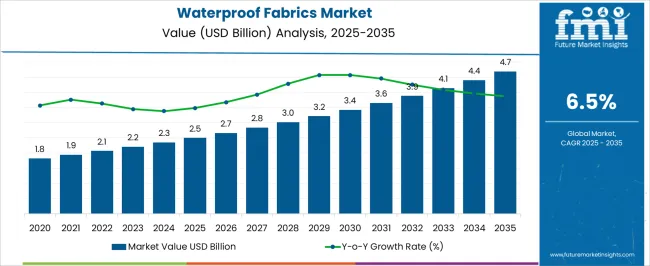
| Metric | Value |
|---|---|
| Waterproof Fabrics Market Estimated Value in (2025 E) | USD 2.5 billion |
| Waterproof Fabrics Market Forecast Value in (2035 F) | USD 4.7 billion |
| Forecast CAGR (2025 to 2035) | 6.5% |
The Waterproof Fabrics market is experiencing steady growth driven by increasing demand across clothing, outdoor gear, and protective industrial applications. The market is shaped by consumer preference for high-performance textiles that combine durability with comfort, particularly in regions with extreme weather conditions. Innovations in breathable and water-resistant technologies are allowing fabrics to maintain comfort while providing protection against moisture, making them attractive for both casual and professional use.
Rising awareness about sustainable and long-lasting materials is also influencing the selection of waterproof fabrics. Furthermore, expanding outdoor recreation activities, the growth of sportswear, and evolving fashion trends that emphasize functional apparel are fueling market adoption.
Technological advancements in fabric coatings, laminates, and composites are enabling lightweight, flexible, and environmentally friendly solutions With increasing investment in research and development, and a focus on multi-functional performance textiles, the market is anticipated to sustain growth, presenting opportunities for innovation in breathable and high-performance waterproof materials across clothing, sportswear, and protective gear applications.
The waterproof fabrics market is segmented by application, type, material, and geographic regions. By application, waterproof fabrics market is divided into Clothing, Tents, Vehicle Covers, Tarpaulins, Sports Wear, and Casual Wear. In terms of type, waterproof fabrics market is classified into Breathable and Non-Breathable. Based on material, waterproof fabrics market is segmented into Polyester, Nylon, Cotton, and Polyurethane. Regionally, the waterproof fabrics industry is classified into North America, Latin America, Western Europe, Eastern Europe, Balkan & Baltic Countries, Russia & Belarus, Central Asia, East Asia, South Asia & Pacific, and the Middle East & Africa.
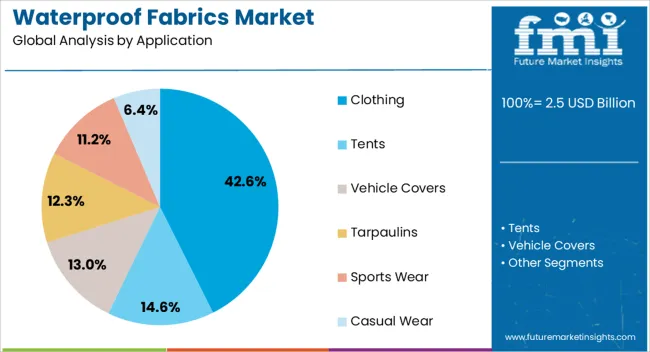
The Clothing application segment is projected to hold 42.60% of the Waterproof Fabrics market revenue share in 2025, establishing it as the leading segment. This dominance is being driven by the growing consumer preference for functional apparel that offers both comfort and protection against rain and moisture. The widespread adoption of waterproof fabrics in outerwear, sportswear, and urban fashion has reinforced the segment’s leadership.
Growth is further supported by advancements in fabric finishing technologies that improve durability while maintaining softness and breathability. Manufacturers are increasingly focusing on lightweight and flexible materials that can be used in multiple layers or as standalone garments.
The demand is also influenced by expanding e-commerce channels and global retail networks that make high-performance clothing more accessible As consumers prioritize long-lasting, weather-resistant garments, the Clothing segment is expected to sustain its leading position, supported by innovations in fabric coatings and laminates that enhance water repellency without compromising comfort.
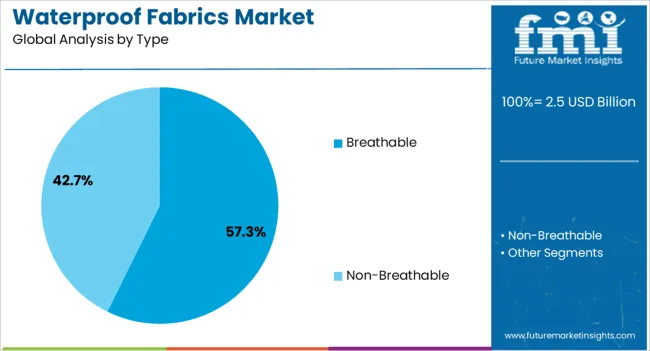
The Breathable type segment is expected to account for 57.30% of the Waterproof Fabrics market revenue share in 2025, emerging as the largest segment in terms of type. This segment has been driven by the need for fabrics that allow moisture and heat to escape while maintaining waterproof performance. Breathable fabrics are particularly valued in activewear, outdoor gear, and professional uniforms, where comfort and temperature regulation are critical.
Technological advancements in microporous membranes, laminates, and coatings have enabled fabrics to combine high water resistance with air and moisture permeability. Growth has also been influenced by consumer demand for multi-functional apparel that supports prolonged activity without discomfort.
The segment’s prominence is reinforced by increasing outdoor recreation participation and growing awareness of ergonomic clothing design Future growth is expected to be supported by continuous innovation in breathable waterproof technologies that enhance comfort, durability, and sustainability for both consumer and professional applications.
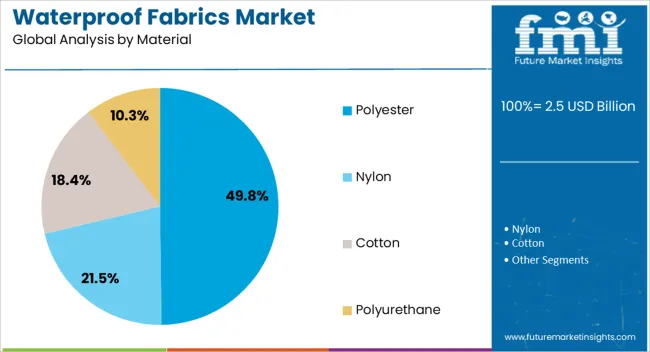
The Polyester material segment is projected to capture 49.80% of the overall Waterproof Fabrics market revenue in 2025, making it the leading material type. This growth is being attributed to the material’s inherent durability, lightweight nature, and resistance to stretching and shrinking. Polyester’s compatibility with advanced coatings and laminates allows manufacturers to create fabrics that are both waterproof and breathable.
The material’s ease of dyeing and finishing also supports aesthetic versatility for fashion and functional applications. Additionally, polyester offers cost-effective production without compromising performance, making it appealing for both commercial and consumer markets.
The adoption of polyester has been reinforced by its suitability for mass production and its ability to integrate with sustainable recycling initiatives, addressing environmental concerns As the demand for long-lasting, high-performance waterproof fabrics continues to grow, polyester is expected to maintain its leading role, supported by ongoing innovations in fabric technology and coating processes that enhance water resistance, durability, and comfort.
Waterproof fabrics are the water repelling fabric materials used in various day to day applications. Waterproof fabrics provide an excellent water resistance with no leakage and minimum wetting. The fabrics are immersion-proofed and wax proofed in order to bring out the maximum efficiency of the waterproof fabrics. The waterproof fabrics provide high durability, are tough, light weight and wrinkle free.
The manufacturers involved in the waterproof fabrics market are focused on improving the texture and finish of the waterproof fabrics. The waterproof fabrics are used in the tents, sportswear, raincoats, tarpaulins, truck covers and kitbags among other applications. On the basis of the material, the waterproof fabrics are categorized by the material type used in the manufacturing the waterproof fabrics. The materials used in the manufacturing of waterproof fabrics include: nylon, polyester, cotton and polyurethane among others
Waterproof fabrics of breathable type are generally designed for garments which are used for the protection from the weather. Breathable waterproof fabrics do not allow water to pass through instead, they allow water vapors to pass in order to maintain the skin and body temperature. Whereas, non-breathable waterproof fabrics do not allow water or water vapors to pass through and thus, are not used in the garments. Non-breathable waterproof fabrics are generally used in the household applications such as bathroom curtains, tents and truck covers
The growth in the per capita disposable income in the developing countries is expected to drive sales of waterproof fabric garments in near future. Automobile industry being one of the key consumer of waterproof fabrics, is expected to drive the waterproof fabrics sales owing to the growing sales and increasing fleet of vehicles in coming years. Conversion of natural fabrics such as cotton and wool to waterproof fabrics using polymer coatings is expected to set a trend in the waterproof fabrics market
Lower efficiency offered by waterproof fabrics when in contact with water for longer time is expected to retard the sales of waterproof fabrics in coming years
North America region is expected to provide a lucrative opportunity for the growth of waterproof fabrics market. The region has reported a significant growth in the automotive vehicle sales and fleet. Owing to which the sales of waterproof fabrics are expected to boost in the North America region in coming years. Europe region is one of the key markets for textile industry. The region holds a prominent share of around 9.7% in the global population owing to which, the sales of the waterproof fabrics are expected to grow at a decent pace in the Europe region in near future.
Latin America region has reported a moderate growth in the sales of the automotive vehicles in recent years. Owing to which the waterproof fabrics market is expected to grow in coming years. Increasing per capita disposable income and fleet of automotive vehicles in the Middle East and Africa region are expected to drive the sales of the waterproof fabrics in coming years.
Asia region is the expected to have a prominent share in the growth of water proof fabrics. Asia region has witnessed a significant growth in the sales and fleet of automotive vehicles. Developing countries in Asia such as India and China who hold a prominent share of 36% of total population of the world are expected to create a platform for the sales of waterproof fabrics in coming years. The increasing per capita disposable income in the China and India is also expected to add in the growth of waterproof fabrics in coming years
The report is a compilation of first-hand information, qualitative and quantitative assessment by industry analysts, inputs from industry experts and industry participants across the value chain. The report provides in-depth analysis of parent market trends, macro-economic indicators and governing factors along with market attractiveness as per segments. The report also maps the qualitative impact of various market factors on market segments and geographies.
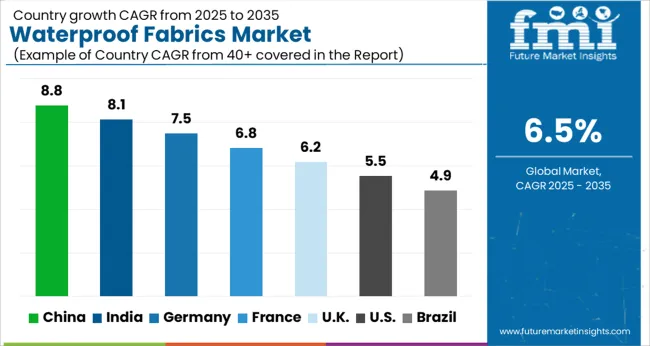
| Country | CAGR |
|---|---|
| China | 8.8% |
| India | 8.1% |
| Germany | 7.5% |
| France | 6.8% |
| UK | 6.2% |
| USA | 5.5% |
| Brazil | 4.9% |
The Waterproof Fabrics Market is expected to register a CAGR of 6.5% during the forecast period, exhibiting varied country level momentum. China leads with the highest CAGR of 8.8%, followed by India at 8.1%. Developed markets such as Germany, France, and the UK continue to expand steadily, while the USA is likely to grow at consistent rates. Brazil posts the lowest CAGR at 4.9%, yet still underscores a broadly positive trajectory for the global Waterproof Fabrics Market. In 2024, Germany held a dominant revenue in the Western Europe market and is expected to grow with a CAGR of 7.5%. The USA Waterproof Fabrics Market is estimated to be valued at USD 892.3 million in 2025 and is anticipated to reach a valuation of USD 1.5 billion by 2035. Sales are projected to rise at a CAGR of 5.5% over the forecast period between 2025 and 2035. While Japan and South Korea markets are estimated to be valued at USD 126.7 million and USD 71.7 million respectively in 2025.
| Item | Value |
|---|---|
| Quantitative Units | USD 2.5 Billion |
| Application | Clothing, Tents, Vehicle Covers, Tarpaulins, Sports Wear, and Casual Wear |
| Type | Breathable and Non-Breathable |
| Material | Polyester, Nylon, Cotton, and Polyurethane |
| Regions Covered | North America, Europe, Asia-Pacific, Latin America, Middle East & Africa |
| Country Covered | United States, Canada, Germany, France, United Kingdom, China, Japan, India, Brazil, South Africa |
| Key Companies Profiled | Toray Industries Inc., Koninklijke DSM N.V., Lafayette USA Corp, Anand Fabrics, Plastitex, Carrington Textiles, Porelle Membranes, Attwoolls Manufacturing, Handloom Bhandar, and Chori Co., Ltd |
The global waterproof fabrics market is estimated to be valued at USD 2.5 billion in 2025.
The market size for the waterproof fabrics market is projected to reach USD 4.7 billion by 2035.
The waterproof fabrics market is expected to grow at a 6.5% CAGR between 2025 and 2035.
The key product types in waterproof fabrics market are clothing, tents, vehicle covers, tarpaulins, sports wear and casual wear.
In terms of type, breathable segment to command 57.3% share in the waterproof fabrics market in 2025.






Our Research Products

The "Full Research Suite" delivers actionable market intel, deep dives on markets or technologies, so clients act faster, cut risk, and unlock growth.

The Leaderboard benchmarks and ranks top vendors, classifying them as Established Leaders, Leading Challengers, or Disruptors & Challengers.

Locates where complements amplify value and substitutes erode it, forecasting net impact by horizon

We deliver granular, decision-grade intel: market sizing, 5-year forecasts, pricing, adoption, usage, revenue, and operational KPIs—plus competitor tracking, regulation, and value chains—across 60 countries broadly.

Spot the shifts before they hit your P&L. We track inflection points, adoption curves, pricing moves, and ecosystem plays to show where demand is heading, why it is changing, and what to do next across high-growth markets and disruptive tech

Real-time reads of user behavior. We track shifting priorities, perceptions of today’s and next-gen services, and provider experience, then pace how fast tech moves from trial to adoption, blending buyer, consumer, and channel inputs with social signals (#WhySwitch, #UX).

Partner with our analyst team to build a custom report designed around your business priorities. From analysing market trends to assessing competitors or crafting bespoke datasets, we tailor insights to your needs.
Supplier Intelligence
Discovery & Profiling
Capacity & Footprint
Performance & Risk
Compliance & Governance
Commercial Readiness
Who Supplies Whom
Scorecards & Shortlists
Playbooks & Docs
Category Intelligence
Definition & Scope
Demand & Use Cases
Cost Drivers
Market Structure
Supply Chain Map
Trade & Policy
Operating Norms
Deliverables
Buyer Intelligence
Account Basics
Spend & Scope
Procurement Model
Vendor Requirements
Terms & Policies
Entry Strategy
Pain Points & Triggers
Outputs
Pricing Analysis
Benchmarks
Trends
Should-Cost
Indexation
Landed Cost
Commercial Terms
Deliverables
Brand Analysis
Positioning & Value Prop
Share & Presence
Customer Evidence
Go-to-Market
Digital & Reputation
Compliance & Trust
KPIs & Gaps
Outputs
Full Research Suite comprises of:
Market outlook & trends analysis
Interviews & case studies
Strategic recommendations
Vendor profiles & capabilities analysis
5-year forecasts
8 regions and 60+ country-level data splits
Market segment data splits
12 months of continuous data updates
DELIVERED AS:
PDF EXCEL ONLINE
Waterproofing Admixtures Market Size and Share Forecast Outlook 2025 to 2035
Waterproof Makeup Market Size and Share Forecast Outlook 2025 to 2035
Waterproof Breathable Textiles WBT Size Market Size and Share Forecast Outlook 2025 to 2035
Waterproof Sneakers Market Analysis - Growth & Forecast 2025 to 2035
Waterproof Socks Market Analysis by Product Type, Application, Consumer Orientation, Sales Channel, and Region Through 2035
Waterproof Boots Market Trends - Growth & Forecast to 2035
Waterproof Shoe Covers Market Analysis - Trends, Growth & Forecast 2025 to 2035
Waterproof Packaging Market Trends - Demand & Industry Forecast 2025 to 2035
Waterproof Speaker Market Analysis - Trends, Growth & Forecast 2025 to 2035
Industry Share Analysis for Waterproof Label Companies
Waterproof Label Market Analysis by Polyethylene & Polypropylene Through 2034
Waterproof Orthotics Market
Waterproof Cases Market
Structural Waterproofing Services Market Size and Share Forecast Outlook 2025 to 2035
Demand for Waterproofing Chemicals in Asia Pacific Size and Share Forecast Outlook 2025 to 2035
Asia Pacific Waterproofing Chemicals Market Analysis - Size, Share, and Forecast 2025 to 2035
Coated Fabrics Market Size and Share Forecast Outlook 2025 to 2035
Hybrid Fabrics Market Size and Share Forecast Outlook 2025 to 2035
Coated Fabrics for Defense Market 2025 to 2035
Nonwoven Fabrics Market Size and Share Forecast Outlook 2025 to 2035

Thank you!
You will receive an email from our Business Development Manager. Please be sure to check your SPAM/JUNK folder too.
Chat With
MaRIA